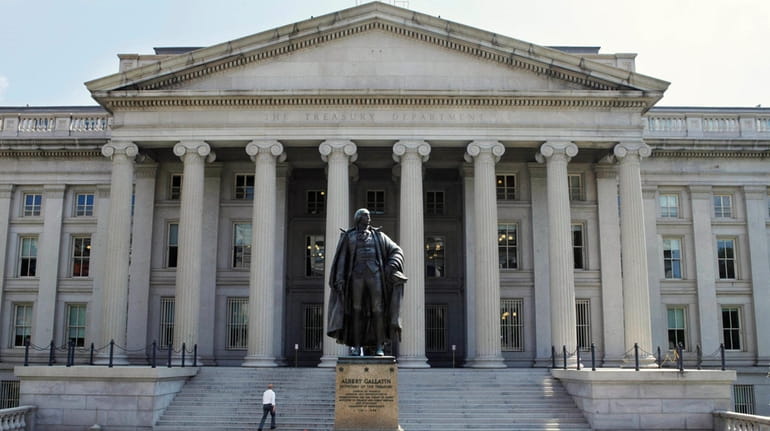Report: New York State gets back 90 cents for each dollar it sends to D.C.

A statue of former Treasury Secretary Albert Gallatin stands guard outside the Treasury Building in Washington, D.C., on Aug. 8, 2011. New York State got back 90 cents in federal spending for every dollar it sent to Washington last year, one of the highest imbalances in payments between the states and federal government, according to a new report. Credit: AP/Jacquelyn Martin
New York State got back 90 cents in federal spending for every dollar it sent to Washington last year, one of the biggest imbalances in payments between the states and federal government, according to a new report.
State Comptroller Thomas DiNapoli, in a 35-page report released Wednesday, found New York residents and businesses sent nearly $250 billion to Washington in income tax payments, Social Security tax, unemployment insurance tax and other payments in the fiscal year ended September 2017.
The state got back $225.7 billion in federal spending, including Medicaid and Social Security payments, grants and salaries for federal employees working in the state.
The imbalance — $24.1 billion — equals 90 cents in federal spending in New York for every dollar sent to Washington.
New Jersey fared worst among the 50 states, getting back 79 cents last year. New Mexico did best, receiving $2.54.
New York placed among the five states with the largest negative balance in payments. States, on average, received a return of $1.19 per tax dollar sent to the federal treasury.
“New York gives more than it gets back from Washington, and threats to cut federal funding for health care and other programs could tip the balance even further,” said DiNapoli, a Democrat from Great Neck Plaza who is seeking re-election. “The state relies on the federal government for a third of its annual budget, but the imbalance of tax dollars remains.”
He said New York received more back from the federal government last year than in 2016, when federal spending equaled 84 cents for every tax dollar sent to Washington. In 2013 it was 91 cents.
DiNapoli said, "It is still uncertain how New York will fare from the impact of last year's major federal tax changes," which capped residents' deductions of state and local taxes on their federal income tax returns.
Wednesday’s report was the third analysis DiNapoli has done of the balance of payments between New York State and the federal government.
The report doesn’t include a breakdown of Long Island’s payments and how much comes back in federal spending.
However, the Long Island Association business group released a report three years ago showing residents and businesses in Nassau and Suffolk counties sent $42.5 billion to the federal government in 2013 and got back $19.4 billion, producing a payments deficit of more than $23 billion.
The 2013 figures do not include federal relief after superstorm Sandy in 2012.
LIA president Kevin Law has said the payments deficits are due, in part, to the federal income tax and alternative minimum tax, both of which particularly hit affluent taxpayers. Personal income on the Island is higher, on average, than in upstate New York and in the country as a whole.
The DiNapoli report shows that last year New York sent Washington $138.7 billion in personal income tax, $81.3 billion in social insurance taxes and $24 billion in corporate income tax — out of a total of $249.9 billion.
In return, New York received $56.7 billion in Social Security, $48 billion in Medicare and $6 billion in veterans' benefits. After these direct payments, grants were the next largest area of federal spending, including $38 billion in Medicaid, $3 billion for highways, airports and mass transit, and $2 billion for elementary and secondary education.
"New York, with 6.1 percent of the nation's population, received higher percentages of federal spending for Medicaid, Supplemental Nutrition Assistance and certain other safety net programs," DiNapoli said Wednesday.
"On the other hand, the state generated 8 percent of the federal government's tax receipts, including 8.8 percent of income tax payments," he said. "Those percentages were higher than our shares of nationwide population and personal income."
Updated 21 minutes ago Gilgo-related search in Suffolk woods ... Urologist trial update ... Construction work zone safety ... Jericho fatal crash
Updated 21 minutes ago Gilgo-related search in Suffolk woods ... Urologist trial update ... Construction work zone safety ... Jericho fatal crash

